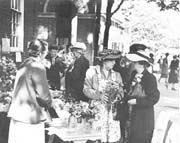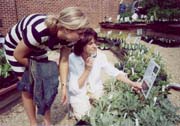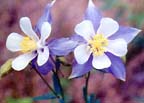|
||||
Buying Nature’s Bounty
|
 |
|
Photo courtesy, Chesapeake Beach Garden Club |
Sat. May 6; 9am-1pm
Gardeners with thumbs of all colors will find this plant sale easy to navigate. The combination plant/yard sale yields homegrown greens from local gardeners’ own collections.
“Some of the plants are houseplants that people are dividing,” says Chesapeake Beach Garden Club member Nancy Feuerle. “We’re asking people to share tomatoes, lilies, hostas and the sort of thing that people have lots of.”
From garden clubbers’ own treasure troves come some 20 different types of plants, including petunias, pansies, sweet potato vines, hosta and houseplants.
“In this area, people have pretty good gardens because the soils are good,” says Feuerle. “We’re a very relaxed garden club — we have fun and don’t get too futzy. Plus, we don’t overprice our plants.”
At Chesapeake Beach Railway Museum, near Rod n’ Reel, Chesapeake Beach: 301-855-2919.
Spring Farm Festival at the Hard Bargain Farm
Sat. May 6; 11am-4pm
The farm beckons as The Alice Ferguson Foundation opens Hard Bargain Farm, a 350-acre farm in Accokeek, Maryland, for dual plant sale and spring festival. Gardeners find unusual native plants as well as traditional spring plants, flowers, herbs, vegetables, fresh-cut flowers and more. Some 80 flats of plants are imported from area nurseries.
The variety of mostly native plants changes each year. It’s too early to tell what this year will bring, but past sales have included such oddities as pitcher plants for wet, bog-type areas.
“Sometimes people want a showy plant, and in general native plants are not as showy, even though they’re very easy to grow,” said Doris Sharp, who’s been at the Alice Ferguson Foundation for 18 years. “In shady areas, good plants are ferns or the lenten rose, which starts blooming in February and blooms into spring. Beautiful also are native trees, like witch hazel.”
Spring at the farm also brings free barnyard demonstrations (including milking, butter churning, sheep shearing, and wool spinning), arts and crafts, music and a picnic overlooking the Potomac River. Kids enjoy hay wagon rides and crafts.
When you buy greens here, your dollars go to the environmental programs at Hard Bargain Farm.
Hard Bargain Farm: Take Exit 3A from I-95; south on Rt. 210; right on Livingston Rd. right on Biddle Rd.; left on Bryan Point Rd. to the farm: 301-292-5665; www.fergusonfoundation.org.
Tawes Garden’s Plant Sale
Wed. May 10; 9am-4pm
Amid the urban gardens of the Tawes Garden, nestled in state office buildings, browse annuals and bedding plants, vegetables and hanging baskets by Friends of Tawes Garden. These plants come from two wholesalers, one that’s brought plants to Tawes before, and one new to the plant sale scene at DNR, run by Tawes’ loyal crew of volunteers.
It’s planned strategically, just before Mother’s Day, says Don Myers, manager of the garden. “We usually have a good variety of things with many colors.”
At Tawes, gardeners will find a few natives, but mostly non-native annuals, bedding plants and vegetable plants.
Buying plants from Tawes means that your greenbacks go back to keeping Tawes green.
Tawes Garden, off Rowe Blvd., by the DNR building, Annapolis: 410-260-8189.
Annapolis Horticultural Society at Anne Arundel Farmers’ Market
Sat. May 13; 7am-noon
 |
|
Photo by, Marion Warren |
Browse for plants as well as your weekly produce during the Annapolis Horticultural Society’s plant sale at the Anne Arundel Farmers’ Market on Riva Road. Some 1,500 plants — mostly perennials, with a few annuals — are dug from Annapolis Horticulture Society members’ private gardens and donated.
Selections this year include shade plants like ferns, spring phlox and native asters; and sun plants like helanthes, sunflowers, Siberian iris and peonies. Gardeners also find hydrangeas, kerria and burning bush. The Society sells potted plants as well as tubers and tips of lily of the valley that they don’t pot.
“These aren’t the plants you usually find in garden centers. Our members usually buy new the things that come out,” says Tish Iorio of the Horticulture Society’s annual fundraiser, which will help pay for their speakers and programs. “It’s all from members’ gardens, so you know that they all grow well in this area.”
Iorio encourages gardeners to think before they dig.
“The most important thing is that people know the sun that hits the area they’re buying for and the ultimate height of the plant they want to put there,” she says. Doing homework first means surveying a garden bed or landscaping area and then finding plants that fit in. “People need to do a little thought work,” she says.
Gardeners should know if they want to have something blooming in that area at all times, or the width of a particular plant bed.
“It’s more than just deciding what flowers they want. If they come with a drawing or sketch, we can recommend plants,” says Iorio, whose group isn’t running a plant clinic but will be on hand to answer questions and help gardeners figure out what plants will work where.
“We have a lot of people that really know what’s going on,” says Iorio.
Anne Arundel County Farmers’ Market, corner of Riva Rd. & Truman Pkwy., Annapolis.
Calvert County Master Gardener’s Plant Sale & Clinic
Sat. May 13 8am-noon
Calvert County Cooperative Extension’s Master Gardeners share their greens and secrets in their biggest event and only fundraiser of the year.
All the plants come from 10 Master Gardeners’ private collections, says president Laura Egnaczyk.
“They’re not nursery grade, but well established,” Egnaczyk says. “It’s sort of like a plant swap, but we don’t accept any other plants that come in.”
The group specializes in native plants, though they will bring some non-invasive aliens. Gardeners typically bring outdoor ornamental perennials like hostas and columbines. They’ll offer some vegetables and herbs like tomatoes, basil, and some houseplants like spider plants, but not many annuals, reports Egnaczyk.
In the past, gardeners have brought in “unique plants that aren’t common at plant sales, like Egyptian onions or raspberries,” says Egnaczyk.
Master Gardner Judy Kay also forecasts lots of species to attract butterflies, small Japanese maples, pussy willows, sweet pepper bush and pink camellias.
Along with foliage, gardeners dole out heaps of free advice.
“It’s a plant clinic as well as a sale, so people can even bring specimens like caterpillars and that kind thing for advice,” Egnaczyk says.
Her pre-sale advice is to hit the local sales before going to a big garden center.
“Come to any of the local garden club sales first to save money, especially with the larger plants, and then fill in with annuals at the store,” she says. “We can teach you how to propagate. A lot of benefits come from hitting the experts up. Get educated before you spend your money.”
Sale held in the parking lot of Calvert Country Market, Prince Frederick Shopping Center: 410-535-3662.
Sotterley Plant Sale & Exchange
Sat. May 13; sale 9am-noon;
exchange 10am-noon
Gardener both bring and take foliage at Historic Sotterley Plantation’s 10th annual free plant exchange.
It’s the easiest way to get into gardening, says exchange organizer Christina Allen, and new gardeners don’t even need to bring anything.
“You can come through the exchange as many times as you want for plants. Everyone gets a flat and fills it up as they go through the different stations,” Allen says. More experienced gardeners typically bring both perennials and annuals: extra plant divisions, seedlings, bulbs, seeds or other green materials to share with other green thumbs.
Typical each year is a wide variety of tomatoes, peppers and other vegetables, plus flowers and small trees. For past sales, gardeners have brought Japanese maple trees, heirloom vegetables and larger plants.
Don’t come late.
“People want to be there at 10am,” Allen says. “When we run out of plants, it’s over.”
The Sotterley Garden Guild also sells plants and bulbs straight from Sotterley’s gardens to raise funds to maintain the garden’s vegetables, herbs and flowers.
Historic Sotterley Plantation, off Rt. 245 at 44300 Sotterley Lane, Hollywood, St. Mary’s County; www.sotterley.org.
Historic Annapolis Foundation
Sat. May 13; 10am-4pm
Sun. May 14; Noon-4pm
The quaint gardens of historic Annapolis inspire as you browse hundreds of varieties of both 18th century heirloom and modern plants.
Historic Annapolis Foundation volunteers grow both hard-to-find and common plants in on-site greenhouses for this annual Mother’s Day weekend sale. So you’ll find natives and exotics from some 200 to 300 varieties of herbs, annuals, perennials, shrubs and trees.
“We grow 10,000 to 11,000 plants in our greenhouses, which right now are stuffed and overflowing,” says Mollie Ridout, director of horticulture for the Historic Annapolis Foundation.
While you can get staples like parsley, you’ll also be able to travel off the beaten path.
“We try to grow things that you don’t typically find in nurseries and in Home Depot,” Ridout said. “We have unusual woodland and heirloom flowers, like some unusual columbines and lenten rose.” Hard-to-find columbines range from the gold and green, 19th century Woodside Varigated to Magpie, a deep purple — almost black — blossom with a white corolla.
Since January, Ridout’s crew of some 35 volunteers has been raising a mixture of heirloom plants you might find in an 18th century garden. Green-thumbed volunteers will be on hand to help you find the right plants for your yard.
They focus on new and old species, Ridout explains, so home gardeners can get the best possible plant. Many heirloom plants have larger blooms or more disease resistance than their more modern hybrid posterity.
“Planting a mixture of modern and heirloom plants is a good way to go,” advises Ridout, “because of the mixture of characteristics. The heirloom is more fragrant and resistant in some plants, and in other species, modern hybridizing gets larger flowers. There’s something to be said for hybridizing.”
William Paca Garden, 186 Prince George St., Annapolis: 410-267-8146.
Providence Center’s Greenhouse
Year-round; 8am-4pm; M-F occasional Fri. evenings & Sa mornings
Spring weekend specials: April 21-May 12: 8am-6pm F; 8am-noon Sa.
Visit the greenhouses of Providence Center — which employs disabled adults to cultivate foliage — year-round for seasonal selections. In fall, get mums; in winter get evergreen wreaths. But now’s the time for spring blooms, like Easter lilies, mums, azaleas, tulips, daffodils, hyacinths and hydrangeas.
Among spring specialties, home gardeners choose from some 1,000 different varieties of plants, says Leslie Mathieson. “We have different types of houseplants, herbs, vegetables, wetland plants and some perennials.”
Variety of native wetland plants sets Providence Center apart.
“We have different varieties of native wetland grasses and a whole line of native upland shrubs, whereas most nurseries don’t have wetland plants,” Mathieson says.
Each species receives personal attention because nurturing plants is nurturing work for Providence Center’s some 30 disabled gardeners. “Everything’s hand-done — watering, filling up pots,” Mathieson says.
Your dollars go back to Providence Center’s greenhouse program and other projects.
The greenhouses are located behind the Bradbury building, 370 Shore Acres Rd., Arnold: 410-757-7800; www.providencecenter.com.



